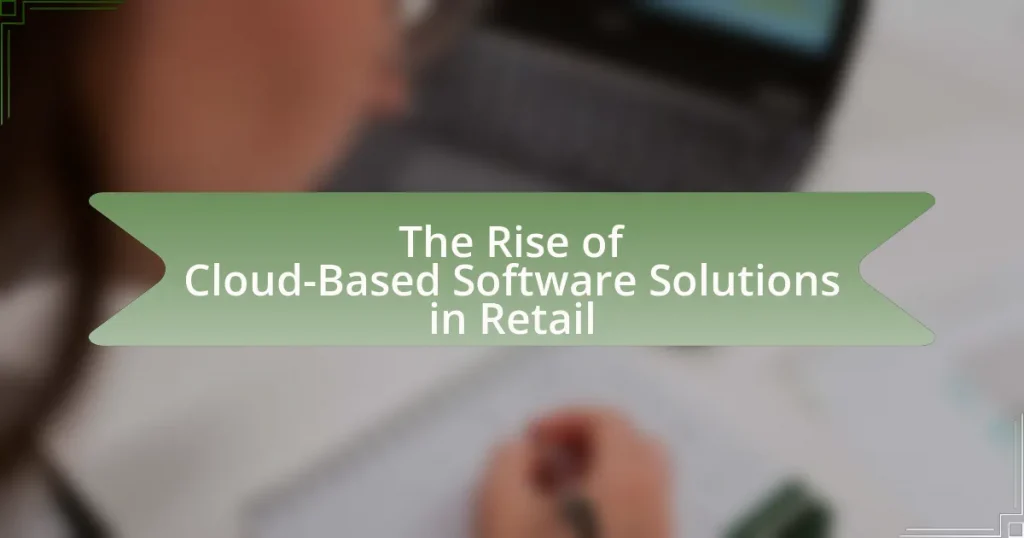The article examines the shift towards open source software in retail markets, highlighting its growing adoption due to benefits such as cost efficiency, flexibility, and innovation. It defines open source software as publicly accessible code that allows for customization and collaborative development, contrasting it with proprietary software. Key characteristics of open source solutions, market demands driving this trend, and the influence of consumer preferences are discussed, along with challenges retailers face during implementation. The article also explores successful case studies, best practices for adoption, and strategies for effective integration and training, emphasizing the significant impact of open source software on retail operations.
What is the Shift Towards Open Source Software in Retail Markets?
The shift towards open source software in retail markets refers to the increasing adoption of open source solutions by retailers to enhance flexibility, reduce costs, and foster innovation. Retailers are moving away from proprietary software due to its high licensing fees and limitations on customization. According to a 2021 report by MarketsandMarkets, the global open source software market is projected to grow from $21.4 billion in 2021 to $57.9 billion by 2026, indicating a significant trend towards open source adoption across various sectors, including retail. This transition allows retailers to leverage community-driven development, improve security through transparency, and integrate with other systems more easily, ultimately leading to improved operational efficiency and customer experience.
How is open source software defined in the context of retail?
Open source software in the context of retail is defined as software whose source code is made publicly available for anyone to inspect, modify, and enhance. This definition emphasizes the collaborative nature of open source, allowing retailers to customize solutions to meet specific operational needs, improve efficiency, and reduce costs. For instance, platforms like Magento and Odoo provide retailers with the flexibility to tailor their e-commerce and inventory management systems, fostering innovation and adaptability in a competitive market.
What are the key characteristics of open source software?
Open source software is characterized by its accessibility, collaborative development, and transparency. Accessibility allows users to view, modify, and distribute the source code freely, fostering innovation and customization. Collaborative development involves contributions from a diverse community of developers, which enhances the software’s functionality and security through peer review. Transparency ensures that users can inspect the code for vulnerabilities and understand how the software operates, promoting trust and reliability. These characteristics are foundational to the open source model, as evidenced by successful projects like Linux and Apache, which have thrived due to their open nature and community involvement.
How does open source software differ from proprietary software?
Open source software differs from proprietary software primarily in its licensing and accessibility. Open source software allows users to view, modify, and distribute the source code, promoting collaboration and transparency, while proprietary software restricts access to the source code and typically requires users to purchase licenses for use. For example, the GNU General Public License governs many open source projects, ensuring that software remains free and modifiable, whereas proprietary software like Microsoft Windows is sold under strict licensing agreements that limit user rights. This fundamental difference influences the development, distribution, and community engagement surrounding each type of software.
Why is there a growing trend towards open source software in retail?
The growing trend towards open source software in retail is primarily driven by the need for cost efficiency, flexibility, and innovation. Retailers increasingly seek to reduce software licensing costs and avoid vendor lock-in, which open source solutions facilitate by allowing customization and integration with existing systems. According to a 2022 report by MarketsandMarkets, the global open source software market is projected to grow from $21.4 billion in 2021 to $57.9 billion by 2026, indicating a significant shift in adoption across various sectors, including retail. This trend is further supported by the collaborative nature of open source communities, which fosters rapid development and access to cutting-edge technologies, enabling retailers to enhance customer experiences and streamline operations.
What market demands are driving this shift?
The market demands driving the shift towards open source software in retail markets include the need for cost efficiency, customization, and enhanced collaboration. Retailers are increasingly seeking to reduce software licensing costs, as proprietary solutions can be expensive and limit flexibility. According to a 2022 report by Gartner, organizations that adopt open source solutions can save up to 30% on software expenses compared to traditional proprietary software. Additionally, the demand for tailored solutions is rising, as retailers require software that can be adapted to their specific operational needs. Open source software allows for greater customization, enabling retailers to modify the code to fit their unique requirements. Furthermore, the collaborative nature of open source communities fosters innovation and rapid development, which is essential in the fast-paced retail environment. This combination of cost savings, customization, and collaboration is driving the shift towards open source software in retail markets.
How do consumer preferences influence the adoption of open source solutions?
Consumer preferences significantly influence the adoption of open source solutions by driving demand for transparency, customization, and community support. As consumers increasingly prioritize these factors, they tend to favor open source software that allows for greater control over features and security. For instance, a survey by the Open Source Initiative found that 78% of respondents valued the ability to modify software to meet specific needs, highlighting a clear preference for customizable solutions. This shift in consumer behavior encourages businesses to adopt open source technologies to align with market demands and enhance customer satisfaction.
What challenges do retailers face when adopting open source software?
Retailers face several challenges when adopting open source software, including integration issues, lack of support, and security vulnerabilities. Integration with existing systems can be complex, as open source solutions may not seamlessly connect with proprietary software already in use. Additionally, retailers often encounter a lack of dedicated support, which can lead to difficulties in troubleshooting and maintenance. Security vulnerabilities are also a significant concern, as open source software can be more susceptible to attacks if not properly managed. According to a 2021 report by the Open Source Security Foundation, 70% of organizations reported security issues related to open source components, highlighting the importance of addressing these challenges effectively.
What are the common misconceptions about open source software?
Common misconceptions about open source software include the belief that it is inherently less secure than proprietary software, that it lacks professional support, and that it is only suitable for developers. In reality, many open source projects have robust security measures and are regularly audited by the community, which can lead to faster identification and resolution of vulnerabilities. Additionally, numerous open source solutions offer professional support options, often through companies that specialize in these products. Furthermore, open source software is widely used across various industries, including retail, demonstrating its versatility and reliability beyond just developer use.
How can retailers overcome technical barriers to implementation?
Retailers can overcome technical barriers to implementation by investing in training and support for their staff. This approach ensures that employees are equipped with the necessary skills to utilize new technologies effectively. Research indicates that organizations that prioritize employee training experience a 20% increase in productivity and a 30% reduction in implementation time. Additionally, collaborating with technology partners can provide retailers with tailored solutions that address specific challenges, further facilitating smoother transitions to new systems.
How does open source software impact retail operations?
Open source software significantly enhances retail operations by providing cost-effective solutions that improve flexibility and customization. Retailers can adapt open source platforms to meet specific business needs without incurring high licensing fees associated with proprietary software. For instance, a study by the Open Source Initiative found that 78% of businesses reported increased operational efficiency after adopting open source solutions, demonstrating the tangible benefits of this approach. Additionally, open source software fosters innovation through community collaboration, allowing retailers to implement cutting-edge technologies more rapidly than traditional software models.
What specific benefits does open source software provide to retailers?
Open source software provides retailers with cost savings, flexibility, and enhanced security. Retailers can significantly reduce software licensing fees by utilizing open source solutions, which often come with no associated costs. This financial benefit allows retailers to allocate resources to other critical areas of their business. Additionally, open source software offers customization options, enabling retailers to tailor solutions to their specific needs, thus improving operational efficiency. Furthermore, the collaborative nature of open source development fosters a community-driven approach to security, allowing for quicker identification and resolution of vulnerabilities compared to proprietary software. This combination of cost-effectiveness, adaptability, and security makes open source software an attractive option for retailers.
How does open source software enhance flexibility and customization?
Open source software enhances flexibility and customization by allowing users to modify the source code to meet specific needs. This capability enables businesses to tailor functionalities, integrate with existing systems, and adapt to changing market demands without being restricted by proprietary software limitations. For instance, companies can add features, fix bugs, or improve performance based on their unique requirements, which is evidenced by the widespread adoption of platforms like WordPress and Magento in retail, where users frequently customize their online stores to optimize user experience and operational efficiency.
What cost savings can retailers expect from using open source solutions?
Retailers can expect significant cost savings from using open source solutions, primarily through reduced software licensing fees and lower total cost of ownership. Open source software eliminates the need for expensive proprietary licenses, allowing retailers to allocate funds to other critical areas. Additionally, the flexibility of open source solutions enables retailers to customize their software to meet specific needs without incurring high development costs associated with proprietary systems. According to a study by the Open Source Initiative, organizations that adopt open source solutions can save up to 30% on software costs compared to traditional proprietary software. This financial advantage, combined with the ability to leverage community support and innovation, makes open source an attractive option for retailers looking to optimize their budgets.
What are the potential risks associated with open source software in retail?
The potential risks associated with open source software in retail include security vulnerabilities, lack of support, and compliance issues. Security vulnerabilities arise because open source code is publicly accessible, making it easier for malicious actors to identify and exploit weaknesses. The lack of dedicated support can lead to challenges in troubleshooting and resolving issues, as retailers may not have access to timely assistance. Additionally, compliance issues can occur if the open source software does not adhere to industry regulations or licensing agreements, potentially exposing retailers to legal risks.
How can security concerns be addressed in open source implementations?
Security concerns in open source implementations can be addressed through rigorous code reviews, regular security audits, and community engagement. Implementing a structured process for code contributions ensures that potential vulnerabilities are identified and mitigated before integration. Regular security audits, conducted by independent experts, help in identifying weaknesses in the codebase, as evidenced by studies showing that proactive security measures can reduce vulnerabilities by up to 50%. Additionally, fostering an active community encourages the reporting and fixing of security issues, as seen in successful projects like Linux and Apache, where community involvement has led to timely patches and updates.
What are the implications of vendor support and community involvement?
Vendor support and community involvement significantly enhance the sustainability and innovation of open source software in retail markets. Strong vendor support provides resources, expertise, and reliability, which are crucial for businesses adopting open source solutions. For instance, companies like Red Hat have demonstrated that dedicated vendor support can lead to increased adoption rates and improved software quality, as evidenced by their substantial market presence and customer satisfaction ratings.
Community involvement fosters collaboration and rapid development, allowing for diverse contributions that enhance software functionality and security. Research from the Linux Foundation indicates that projects with active community participation experience faster release cycles and more robust security updates. This collaborative environment not only drives innovation but also creates a sense of ownership among users, leading to greater long-term commitment to the software.
In summary, the implications of vendor support and community involvement are profound, as they collectively contribute to the growth, reliability, and evolution of open source software in the retail sector.
What are some successful case studies of open source software in retail?
Some successful case studies of open source software in retail include the use of Magento by companies like Coca-Cola and Nike, which leverage its customizable e-commerce platform to enhance online sales and customer engagement. Additionally, the use of Openbravo by companies such as Unilever demonstrates how open source ERP solutions can streamline operations and improve inventory management. These implementations showcase the effectiveness of open source software in driving efficiency and innovation in retail environments.
Which retailers have effectively implemented open source solutions?
Retailers that have effectively implemented open source solutions include Walmart, Target, and Best Buy. Walmart has utilized open source technologies to enhance its supply chain management and improve customer experience through data analytics. Target has adopted open source software for its e-commerce platform, enabling greater flexibility and innovation. Best Buy has leveraged open source solutions to optimize its inventory management and enhance its online shopping experience. These implementations demonstrate the retailers’ commitment to leveraging open source for operational efficiency and customer engagement.
What lessons can be learned from these case studies?
The lessons learned from the case studies on the shift towards open source software in retail markets include the importance of collaboration, cost efficiency, and adaptability. Collaboration among developers and retailers fosters innovation and accelerates problem-solving, as evidenced by successful partnerships that have led to enhanced software solutions. Cost efficiency is highlighted by the reduced licensing fees associated with open source software, allowing retailers to allocate resources more effectively, which is supported by data showing significant savings for companies that adopt open source solutions. Lastly, adaptability is crucial, as open source software allows retailers to customize their systems to meet specific needs, a fact demonstrated by case studies where tailored solutions improved operational efficiency and customer satisfaction.
What best practices should retailers follow when adopting open source software?
Retailers should follow best practices such as conducting thorough research, ensuring compliance with licensing, and fostering community engagement when adopting open source software. Conducting thorough research allows retailers to evaluate the software’s capabilities and community support, which is crucial for long-term sustainability. Ensuring compliance with licensing agreements protects retailers from legal issues and helps maintain the integrity of the software. Fostering community engagement encourages collaboration and access to shared resources, enhancing the retailer’s ability to innovate and troubleshoot effectively. These practices are supported by the growing trend of retailers leveraging open source solutions to reduce costs and increase flexibility, as evidenced by a 2021 report from the Open Source Initiative, which highlighted a 30% increase in open source adoption among retailers.
How can retailers evaluate and select the right open source solutions?
Retailers can evaluate and select the right open source solutions by assessing their specific business needs, analyzing the community support and documentation available, and evaluating the software’s compatibility with existing systems. Identifying business requirements ensures that the chosen solution aligns with operational goals. Community support is crucial, as robust communities often indicate better maintenance and updates, which enhances reliability. Compatibility with existing systems is essential to avoid integration issues, ensuring a smoother implementation process. According to a 2021 report by Gartner, 70% of organizations that adopted open source solutions cited community support as a key factor in their selection process, highlighting its importance in decision-making.
What strategies can be employed for successful integration and training?
Successful integration and training in the context of open source software in retail markets can be achieved through comprehensive onboarding programs, continuous education, and community engagement. Comprehensive onboarding programs ensure that employees understand the software’s functionalities and how it aligns with business processes. Continuous education, such as workshops and online courses, keeps staff updated on new features and best practices, enhancing their proficiency. Community engagement fosters collaboration and knowledge sharing among users, which can lead to innovative solutions and improved problem-solving. These strategies are supported by studies indicating that organizations with structured training programs experience higher employee satisfaction and productivity, ultimately leading to successful software adoption.



